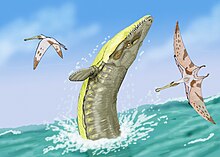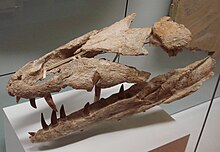噬蜥鳄属
| 噬蜥鳄属 化石时期:
| |
|---|---|

| |
| 巨噬蜥鳄自海面跃起,企图猎食两只翼龙类 | |
无效状况
| |
| 科学分类 | |
| 界: | 动物界 Animalia |
| 门: | 脊索动物门 Chordata |
| 纲: | 爬行纲 Reptilia |
| 科: | †中喙鳄科 Metriorhynchidae |
| 亚科: | †地蜥鳄亚科 Geosaurinae |
| 族: | †地蜥鳄族 Geosaurini |
| 属: | †噬蜥鳄属 Dakosaurus von Quenstedt, 1856[1] |
| 模式种 | |
| 巨噬蜥鳄 Dakosaurus maximus (Plieninger, 1846)
| |
| 种 | |
| 异名 | |
| |
噬蜥鳄属(学名︰Dakosaurus),又译达克龙或达寇龙。是中喙鳄下的一个属,体型大,牙齿有锯齿,侧向扁平。噬蜥鳄是肉食性动物,大部分时间都生活于海洋中。从它们那适应海中生活的特征,可见它们很可能是在海中交配。不过由于仍未有噬蜥鳄的蛋或巢被发现,究竟它们是否如海豚及鱼龙类般在海中出生,或是像龟在岸上出生,仍是未知。
噬蜥鳄命名于1956年,由Friedrich August von Quenstedt根据数颗Th. Plieninger挖出的牙齿建立,当时为地蜥鳄。
词源学
[编辑]噬蜥鳄的属名Dakosaurus来自希腊语 dakos,意为“噬咬”与sauros 意为“蜥蜴”,即“噬咬蜥蜴”,因为其双颚长有锋利的牙齿。[6][7]
发现与物种
[编辑]

在19世纪,噬蜥鳄的最早化石发现于德国,这些分散的牙齿曾被误认为属于兽脚亚目的巨齿龙[8]。在1856年,德国古生物学家von Quenstedt将Plieninger命名的巨地蜥鳄(Geosaurus maximus)牙齿化石,命名为噬蜥鳄(Dakosaurus)[9]。在当时,von Quenstedt认为噬蜥鳄是种恐龙[10]。
噬蜥鳄的化石已在英格兰、法国、瑞士、德国[6]、波兰[11]、俄罗斯[12]阿根廷、[3]、以及墨西哥等地发现[13]。另外在欧洲各地也发现噬蜥鳄的牙齿,年代属于牛津阶到凡蓝今阶[14][15]。
有效种
[编辑]在噬蜥鳄属中的物种包括:
- 巨噬蜥鳄(D. maximus):模式种,化石从西欧(英格兰、法国、瑞士及德国)发现,生活于晚侏罗纪(晚启莫里阶至早提通阶)[6][7]。
- 安第斯噬蜥鳄(D. andiniensis):生活于晚侏罗纪(晚提通阶)至上白垩纪(早贝里亚阶)。化石于1987年发现于阿根廷内乌肯省,但在1996年才建立名称[3]。两个近年发现的头骨,口鼻部短而高,显示安第斯噬蜥鳄在中喙鳄科(最适应海洋生活的鳄鱼)中相当独特;也使安第斯噬蜥鳄有“哥斯拉”的昵称[16]。
- 尼西亚噬蜥鳄(D. nicaeensis):最初在1913年被分类为巨齿龙科恐龙。在1982年,被归类为地蜥鳄科的安吉奥拉鳄属Aggiosaurus,并是噬蜥鳄的近亲[17]。模式标本的保存状态差,因此被认为是疑名。在2009年的地龙重新研究,研究了相关物种的有效性、互相关系。在这份研究中,研究人员认为Aggiosaurus是达克龙的次异名[4]。
未命名种
[编辑]在墨西哥的一个地层,发现了噬蜥鳄的不完整头骨,年代为启莫里阶[13][18]。


分类
[编辑]Dacosaurus是拼法错误[5]。根据2007年的亲缘分支分类法研究,噬蜥鳄属不是个单系群[19],巨噬蜥鳄与安第斯噬蜥鳄似乎另外形成一个单系群[16][19][20]。
| |||||||||||||||||||
已下演化树则来自于2011年的地蜥鳄科体型研究[22]:
| |||||||||||||||||||
古生物学
[编辑]
体型
[编辑]所有已知的噬蜥鳄物种都约为4到5米长,噬蜥鳄算是大型生物。它的身体呈流线形,提供了强大的水动力。配合它那有鳍的尾巴,使它游泳比现今鳄鱼更有效率[23]。
盐腺
[编辑]在墨西哥发现的不完整头骨,其头骨内有疑似盐腺的腔室;地蜥鳄[24]与中喙鳄也有相同的盐腺[25]。但没有确切证据显示这些腔室内含盐腺[13]。
生态位
[编辑]德国巴伐利亚州的Mörnsheim组(属于索伦霍芬石灰岩,年代为早提通阶)发现了5种海鳄类化石,其中包含巨噬蜥鳄龙、其他3种地蜥鳄、狭蜥鳄的化石。科学家提出这些海鳄颣的生态位不同,依此得以互相共存。噬蜥鳄与巨型地龙的体型大,口鼻部短,有锯齿状牙齿,似乎是当地的顶级掠食动物。纤细地龙、G. suevicus与真蜥鳄科狭蜥鳄可能主要以鱼类为食[26]。
德国南部的Nusplingen石灰岩层,年代较索伦霍芬石灰岩晚,属于启莫里阶晚期。当地发现了G. suevicus与巨噬蜥鳄(D. maximus)的化石。与索伦霍芬的状况相同,噬蜥鳄是顶级掠食动物,而G. suevicus主要以鱼类为。[27]。

食性
[编辑]在海鳄类中,噬蜥鳄是唯一牙齿呈锯齿状、侧向扁平,类似虎鲸;噬蜥鳄的体型也比其他地蜥鳄类大。[16]这些特征显示噬蜥鳄是种顶级掠食者[28]。
噬蜥鳄的上颞孔(Supratemporal fenestrae)大[7],上颞孔可提供内收肌的附着点[29],这意味达寇龙的咬合力大。噬蜥鳄的头骨呈三角形,牙齿大、呈锯齿状、齿根深(类似上龙类),意味噬蜥鳄会采猛烈撕咬猎物身体的方式为食[30]。
参考
[编辑]- ^ 1.0 1.1 Quenstedt FA. 1856. Sonst und Jetzt: Populäre Vortäge über Geologie. Tübingen: Laupp, 131.
- ^ Plieninger T. 1846. Prof. Dr. Th. Plieninger hielt nachstehenden vortrag über ein neues Sauriergenus und die Einreihung der Saurier mit flachen, schneidenden Zähnen in eine Familie. Pp. 148-154 in: Zweite Generalversammlung am 1. Mai 1846 zu Tübingen. Württembergische naturwissenschaftliche Jahreshefte 2: 129-183.
- ^ 3.0 3.1 3.2 Vignaud P, Gasparini ZB. 1996. New Dakosaurus (Crocodylomorpha, Thalattosuchia) from the Upper Jurassic of Argentina. Comptes Rendus de l'Académie des Sciences, Paris, 2 322: 245-250.
- ^ 4.0 4.1 Young, Mark T., and Marco Brandalise de Andrade, 2009. "What is Geosaurus? Redescription of Geosaurus giganteus (Thalattosuchia: Metriorhynchidae) from the Upper Jurassic of Bayern, Germany." Zoological Journal of the Linnean Society, 157: 551-585.
- ^ 5.0 5.1 Sauvage HE. 1873. Notes sur les reptiles, fossiles. Bulletin de la Société Géologiques de France, série 3: 365-384.
- ^ 6.0 6.1 6.2 Steel R. 1973. Crocodylia. Handbuch der Paläoherpetologie, Teil 16. Stuttgart: Gustav Fischer Verlag,116 pp.
- ^ 7.0 7.1 7.2 Fraas E. 1902. Die Meer-Krocodilier (Thalattosuchia) des oberen Jura unter specieller Berücksichtigung von Dacosaurus und Geosaurus. Paleontographica 49: 1-72.
- ^ Quenstedt FA. 1843. Das Flötzgebirge Württembergs: mit besonderer rücksicht auf den Jura. Tübingen: Laupp, 493.
- ^ Quenstedt FA. 1858. Der Jura. Tübingen: Laupp, 842 pp.(pgs. 785-786)
- ^ Quenstedt FA. 1859. Handbuch der Petrefaktenkunde. Tübingen: Laupp, 1239 pp.
- ^ Radwańska U, Radwański A. 2003. The Jurassic crinoid genus Cyclocrinus D’Orbigny, 1850: still an enigma. Acta Geologica Polonica 53 (2003),(4): 301-320.
- ^ Ochev VG. 1981. [Marine crocodiles in the Mesozoic of Povolzh'e] Priroda 1981: 103
- ^ 13.0 13.1 13.2 Buchy M-C, Stinnesbeck W, Frey E, Gonzalez AHG. 2007. First occurrence of the genus Dakosaurus (Crocodyliformes, Thalattosuchia) in the Late Jurassic of Mexico. Bulletin de la Societe Geologique de France 178 (5): 391-397.
- ^ BM(NH), Trustees of the. 1983. British Mesozoic Fossils, sixth edition. London: Butler & Tanner Ltd, 209 pp.
- ^ Benton MJ, Spencer PS. 1995. Fossil Reptiles of Great Britain. London: Chapman and Hall, 386 pp.
- ^ 16.0 16.1 16.2 Gasparini Z, Pol D, Spalletti LA. 2006. An unusual marine crocodyliform from the Jurassic-Cretaceous boundary of Patagonia. Science 311: 70-73.
- ^ Buffetaut E. 1982. Aggiosaurus nicaeensis Ambayrac, 1913, from the Upper Jurassic of south-eastern France: A marine crocodilian, not a dinosaur. Neues Jahrbuch für Geologie und Paläontologie, Monatshefte (8): 469-475.
- ^ Buchy M-C. 2008. New occurrence of the genus Dakosaurus (Reptilia, Thalattosuchia) in the Upper Jurassic of north-eastern Mexico with comments upon skull architecture of Dakosaurus and Geosaurus. Neues Jahrbuch für Geologie und Paläontologie, Abhandlungen 249 (1): 1-8.
- ^ 19.0 19.1 Young MT. 2007. The evolution and interrelationships of Metriorhynchidae (Crocodyliformes, Thalattosuchia). Journal of Vertebrate Paleontology 27 (3): 170A.
- ^ Wilkinson LE, Young MT, Benton MJ. 2008. A new metriorhynchid crocodilian (Mesoeucrocodylia: Thalattosuchia) from the Kimmeridgian (Upper Jurassic) of Wiltshire, UK. Palaeontology 51 (6): 1307-1333.
- ^ Andrea Cau; Federico Fanti. The oldest known metriorhynchid crocodylian from the Middle Jurassic of North-eastern Italy: Neptunidraco ammoniticus gen. et sp. nov. Gondwana Research. 2011, 19 (2): 550–565. doi:10.1016/j.gr.2010.07.007.
- ^ Mark T. Young, Mark A. Bell, Marco Brandalise de Andrade and Stephen L. Brusatte. Body size estimation and evolution in metriorhynchid crocodylomorphs: implications for species diversification and niche partitioning. Zoological Journal of the Linnean Society. 2011, 163 (4): 1199–1216 [2012-03-22]. doi:10.1111/j.1096-3642.2011.00734.x. (原始内容存档于2017-12-09).
- ^ Massare JA. 1988. Swimming capabilities of Mesozoic marine reptiles; implications for method of predation. Paleobiology 14 (2):187-205.
- ^ Fernández M, Gasparini Z. 2000. Salt glands in a Tithonian metriorhynchid crocodyliform and their physiological significance. Lethaia 33: 269-276.
- ^ Gandola R, Buffetaut E, Monaghan N, Dyke G. 2006. Salt glands in the fossil crocodile Metriorhynchus. Journal of Vertebrate Paleontology 26 (4): 1009-1010.
- ^ Andrade MB, Young MT. 2008. High diversity of thalattosuchian crocodylians and the niche partition in the Solnhofen Sea (页面存档备份,存于互联网档案馆). The 56th Symposium of Vertebrate Palaeontology and Comparative Anatomy
- ^ Dietl G, Dietl O, Schweigert G, Hugger R. 2000. Der Nusplinger Plattenkalk (Weißer Jura zeta) - Grabungskampagne 1999.
- ^ Massare JA. 1987. Tooth morphology and prey preference of Mesozoic marine reptiles. Journal of Vertebrate Paleontology 7: 121-137.
- ^ Holliday CM, Witmer LM. Archosaur adductor chamber evolution: integration of musculoskeletal and topological criteria in jaw muscle homology. Journal of Morphology 268 (6): 457-484.
- ^ Martill DM, Taylor MA, Duff KL, Riding JB, Brown PR. 1994. The trophic structure of the biota of the Peterborough Member, Oxford Clay Formation (Jurassic), UK. Journal of the Geological Society, London 151: 173-194.
外部链接
[编辑]- Scientists reveal prehistoric terror(页面存档备份,存于互联网档案馆) - CNN
- Illustration(页面存档备份,存于互联网档案馆) - National Geographic



